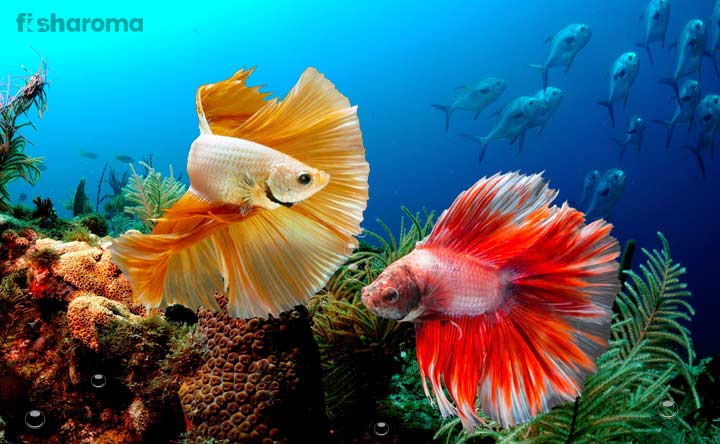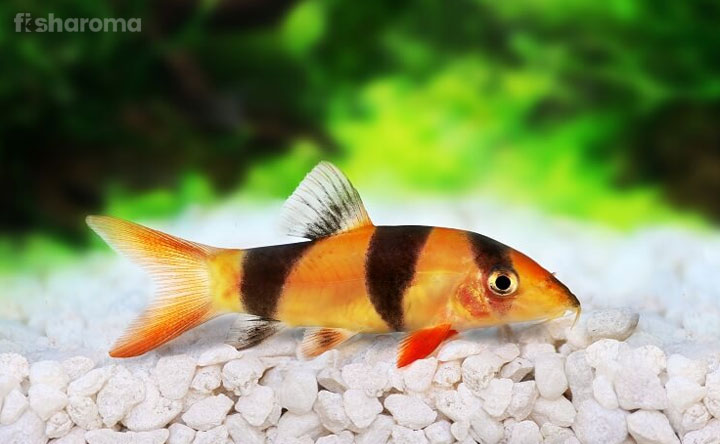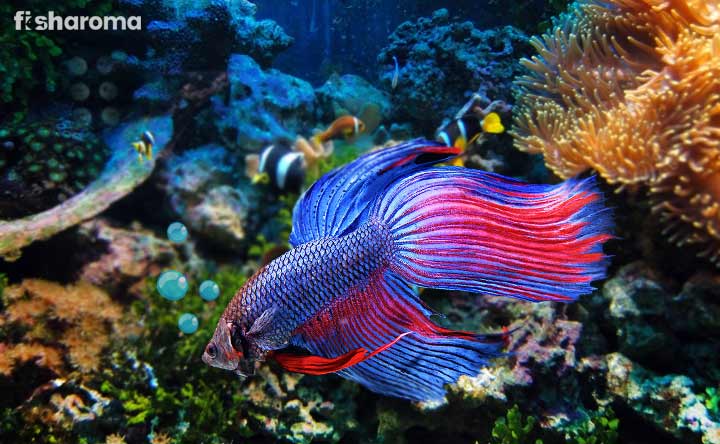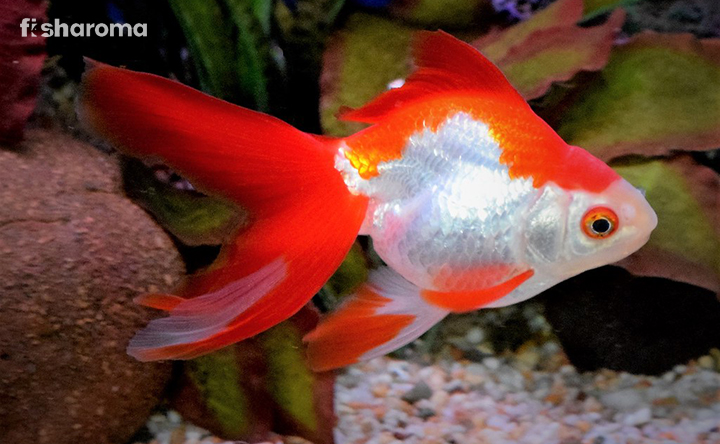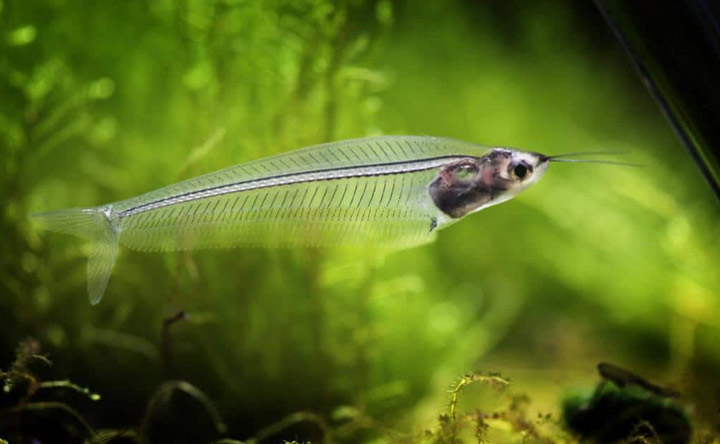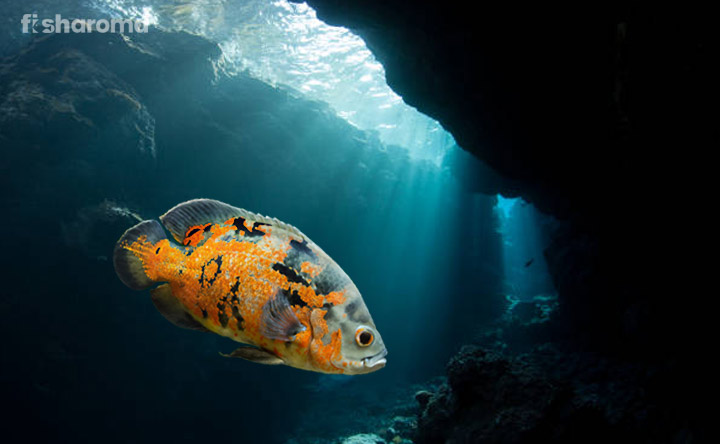The Complete Care Guide of the Magnificent Jewel Cichlid

True to their name, Jewel Cichlids can embellish your aquarium in a way that can’t be done by any other species. These magnificent creatures are not only popular because of their beauty but also because of how fun they are to watch since they are highly active and in fact, extremely aggressive. Therefore, it goes without saying that having a detailed knowledge as to how to pet them healthily. This is why we are bringing before you an all-inclusive care guide for the same.
Key Specifications of Jewel Cichlid
Now, before we dig deep into each aspect of their care guide separately, let us take a quick look at some of their key specifications from the table below.
| Scientific Name | Hemichromis bimaculatus |
| Origin | West Africa |
| Lifespan | 5+ years |
| Colours | Red/orange, blue |
| Temperament | Aggressive |
| Size | 5.5” (14 cm) |
| Diet | Omnivore |
| Family | Cichlidae |
| Compatibility | Low |
| Tank Size | 30 gallons |
| Care Level | Moderate |
Overview
Belonging to the Cichlidae family, Jewel Cichlids are great pets for home aquariums, but are not recommended for community tanks owing to their aggressive nature. Their scientific name is Hemichromis bimaculatus. They are also known as Jewel Fish, Green Jewels, Blue Jewels, and African Jewelfish, among others.
For them to survive in a captive environment, you need to put in major efforts. So, if you are not really up for the commitment, this is not the fish for you.
Origin & Habitat of Jewel Cichlid
Native to West Africa, Jewel Cichlids need a lot of hiding space in their vicinities. As such, having vegetation in the tank that you host them is considered to be a good idea.
In the wild, they neither live in a too bright place nor in a too dark place. So adjust the lighting accordingly. They have a preference for sandy substrate. In a way, they essentially thrive in the muddy bottoms of freshwater bodies in the wild.
Appearance of Jewel Cichlid
Jewel Cichlids have pointy, narrow bodies. They also have a small bump at the beginning of their back which is more prominent in the younger Jewel Cichlids. The heads of these fish slant upwards and have a visible curve towards the back.
Their anal fins are extremely tiny and extend the exact same spot as their dorsal fish, meaning they start way up on front third of their bodies. Both these fins end just before the caudal fins start.
Size of Jewel Cichlid
In a captive environment, they can grow up to 5.5” (14 cm), but in the wild, they can grow as large as 12” (30.5 cm). This is one of the biggest differences in size between the captive and wild version of a fish.
Colour of Jewel Cichlid
Despite them being available in a range of colours, you would mostly find them in orange or red colour. Most of the Jewel Cichlids have green or blue spots all over their bodies, which give them their signature beautiful look.
These colours are also seen in their fins. However, they are there in stripe form instead of spots.
Behaviour of Jewel Cichlid
As we have stated above, Jewel Cichlids are regarded among the more aggressive species out there. Their aggression increases when they are more stressed. Therefore, as a pet owner, it is your responsibility to ensure that your Jewel Cichlid stay stress-free.
They are extremely territorial and you would have to provide them with their own space in order to reduce their aggression. Their aggression increases when they are mating. So, please provide a separate breeding tank to them during those times.
When they get aggressive, they can nip other fish or even get into full-blown fights with them. Providing them with the right living conditions and not disturbing them (such as by making sure that people don’t knock on the glass walls of their tank or trying to scare them in any shape of form) can significantly lower their stress levels.
They are highly energetic and spend a lot of time digging substrate. Another important aspect of their personalities is that they are very protective parents. They would never abandon their young ones and are known for their strong parental instincts.
Lifespan of Jewel Cichlid
These fish require your attention and care. If you are unable to provide them with the care they need, they would meet untimely demise. However, if you are able to provide them with a healthy environment, they can live up to more than five years.
Diet of Jewel Cichlid
They are omnivorous by nature. The aggression of these fish can also be controlled by how often you are feeding them and what you are feeding them. Please note that these fish are not picky eaters and have a wide range when it comes to their diet, be it live food or pellets and flakes. In fact, mixing the food up by providing pellets and flakes for five days a week and live food two days a week is the ideal way to go.
Brine Shrimps and Bloodworms are excellent choices for live food options. Make sure, live foods are given to them in forms of treats and not regular foods. When they are hungry for a long time, they can get cranky and their aggression may rise. Providing them with a mix range of food ensures bright coloration.
Tank Requirements of Jewel Cichlid
Let us now take a look at the things you need to bear in mind while setting the tank of a Jewel Cichlid:
Tank Size
These are significantly are large aquatic pets. Therefore, having a 30-gallon tank for a single Jewel Cichlid is recommended although if you can manage a 40-gallon tank, it would be even better. For each additional Jewel Cichlid you add to the tank, please increase the tank size by 10 gallons.
Tank Lid
Using a tight lid in your aquarium will not only keep them protected from dogs, cats and children but would also ensure that there are no dust or dirt getting accumulated in the tank water.
Substrate
Usually, they thrive in a sandy substrate. You may use gravel-based substrates for them too. But, remember, they spend a lot of time digging in the wild. So, sand should be your first choice with a few gravels here and there. Also, make sure the sand has fine grains and there are no sharp objects that may cause any injury to them while digging.
Filter
Use a proper filtration system in your tank since this is essential for maintaining the good health of your Jewel Cichlids.
Ornaments
As far as ornaments are concerned, you can get creative. Use castle, caves, and decorate your tank with pebbles and rocks as you please. Make sure none of them have any toxic colouring or any sharp edges. Also, you need to ensure that the hole of the caves and castles are large enough so that your fish don’t get stuck in them.
Presence of Flora
In their natural habitat, they are surrounded by thick vegetation. So, provide background plants in their tank. However, ensure that you are using sturdy plants since they are known for nibbling the leaves.
Lighting
Keep moderate lighting in the tank that you host them. They don’t need too strong or too dull lighting.
Cleaning Method
Cleaning the tank on a regular basis would ensure that they stay healthy. We recommend that you clean the tank at least once a month.
For cleaning the interior walls, you can use a soft cloth dipped in lukewarm water to wipe off any dirt or dust. You can use an algae-scraper to get rid of algae. For the substrate and other ornaments, you can put them under running water to clean them. Don’t use any chemical or soap-based products for them since they would leave behind harmful residue even when you wash thoroughly.
Water Type for Jewel Cichlid
Let us now focus on the type of water you need to provide to them for ensuring their good health. You can either use distilled water or try and dilute tap water in order to ensure the right conditions.
Temperature
We recommend keeping ideal temperature of the water should be 68-82.4° F (20°-28° C). You can use an aquarium heater and an aquarium thermometer in case your heater doesn’t have a thermometer reading.
pH Level
You can use peat moss or pellets or even almond leaves n your tank since they release tannins which naturally help in lowering the pH level.These fish prefer slightly acidic and soft water. As such, try to keep the pH level of the water 5-6.
Hardness
The carbonate hardness of the tank water where you keep Chili Rasboras in should be 9-11 dKH.
Replacement Procedure
When you are replacing the water, keep the parameters (temperature, pH level, hardness, etc.) of the new batch of water the same as that of the existing batch of water. Also, never replace the entire water content altogether as this would kill off the beneficial bacteria needed for maintaining the balance in the ecosystem of your aquarium. Regular replacement of the water would help in keeping them healthy.
You can replace 10 per cent of the water on a weekly basis or 25 per cent of the water every 15 days. Else, you can replace 40 per cent of the water on a monthly basis. Choose any of the three.
Compatibility of Jewel Cichlid
As they are not schooling fish, they obviously are not compatible with one another. For creating a school, you would need at least a minimum of six of them together. However, they stay much when you keep them alone.
Suitable Tankmates for Jewel Cichlids
They are aggressive and they can survive being kept with a bunch of other species, especially those that are small in stature and peaceful by nature just like them. They don’t bode well with small invertebrates or quiet fish.
Some of the ideal tankmates for Chili Rasboras are as follows:
- Wood Shrimp
- Amano Shrimp
- Cory Catfish
- Sparkling Gourami
- Chocolate Gourami
- Celestial Pearl Danio
- Neon
- Cherry Shrimp
Unsuitable Tankmates for Jewel Cichlids
Please sure that you don’t keep them with larger or aggressive species since not only they would steal their food but also make food out of them.
Breeding of Jewel Cichlid
For encouraging breeding, you would need 1-2 females per male in a tank. Ideally, we recommend adding a small group of Jewel Cichlids to a spawning container with mesh at the bottom.
Make sure the water parameters (Temperature, pH level and hardness) are always consistent.
Once the female lays the eggs, neither her nor the male make much effort into taking care of the eggs. In fact, they cannibalize their eggs. Male Jewel Cichlids turn bright red they are ready to breed. They also become highly territorial during these times. You will also find them trying to draw the attention of the females in a number of different ways.
Once the eggs hatch, you can feed them paramecium and Infusoria until they grow up. You can, therefore, keep the eggs in a separate tank. If you don’t have enough, make sure your existing tank has enough hiding spots and is dense enough for them to survive from the threat of others.
The mesh should be large enough for the eggs to fall through but small enough so that the parent can’t access the eggs to eat them. Don’t keep them in the breeding tank for more than 3-4 days since they might fall sick.
Summary
Make sure to regularly clean the tank and quarantine everything including the fish themselves before adding them to the main tank. If you notice any abnormalities in them such as lesions, bloating, pimples, ulcers, grey spots, discoloured scales, etc., then immediately contact a veterinarian. Make sure that they don’t cannibalize their eggs by providing a mesh at the bottom.
Jewel Cichlids are among the most magnificent creatures that you can pet in your home. They are pretty non-demanding when it comes to their tank mate and dietary requirements. Breeding them is also pretty easy. They are, however, prone to various disease, most of which arise from not keeping the tank clean. As long as you consistently keep the tank clean, you don’t even have to worry too much about their tank conditions.
Care Guides of Other Similar Pets
If this article has caught your interest, then we are sure that the following articles would also catch your interest too:
- Flowerhorn Cichlid Care Guide: Regarded as one of the most beautiful types of Cichlids out there, they will completely uplift the aesthetics of your freshwater tank.
- Red Devil Cichlid Care Guide: Bring a dash of redness to your freshwater tank by bringing home these amazing cichlids.
- Firemouth Cichlid Care Guide: These fiery-temperament cichlids are known for their dynamic behaviour since there’s never a dull moment when you have them in your tank.

